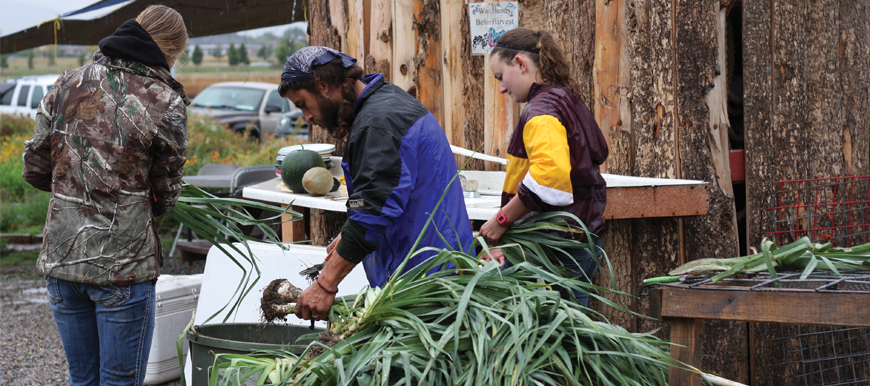Organic farm celebrates harvest with Pumpkin Days
Editor’s note: this story was published previously on hardnewscafe.usu.edu.
What began with mud ended with mud as Utah State University’s Organic Farm celebrated the end of the growing season with Pumpkin Days on Saturday. While some participants took shelter under tarps to listen to local bands and drink hot chocolate, others ventured into the rain to gather pumpkins and other produce ready for harvest.
“Our shares have been really successful,” said Tracey Munson, the organic farm manager. “It’s kind of hard to harvest everything during school because there is so much produce.”
The harvest accumulated approximately $2,000 in profit for on-campus sales, $500 more than last year, said former organic farmer manager Nathan Staker.
“We still have a couple weeks that we have to be selling,” Staker said. “We have pumpkins that we are going to be selling up there [on USU campus] this year.”
Although this year’s harvest was a success on campus, lack of snow and dry conditions early in the year lead to some dried out crops, Munson said.
“I’m sure there are things that would have gotten bigger had there been more water, like our carrots,” Munson said. “Our last batch of carrots were pretty small, and had they gotten more water, they would have been bigger.”
Getting crops to grow big and in season can be a challenge considering organic farms do not use any fertilizers containing chemicals, Staker said. Without chemical fertilizers, the farm has to use alternative ways of achieving optimal levels of nitrogen, a chemical element that is important to the health of the crops, into the soil.
“The produce tends to take two to four weeks longer than if you were to use fertilizer,” Staker said. “For our farm, I’d say that it’s two weeks later because we use cover crops, plants that are high in nitrogen, that we will fill into the field that gives up that nitrogen. So right out in the field you’ll see that green-colored grass? That’s called winter wheat. There’s other implements that we can use if we see plants are struggling, one of which is bone meal, an organic fertilizer, and there’s also fish fertilizer.”
An even bigger concern for this year’s crops were heat waves, which harmed the crops from last year, Staker said.
“I really wasn’t concerned about drought weather,” Staker said. “What caused concern for me was if we were going to have the hot heat waves again. We had a lot of crops last year that really didn’t care for it and struggled through the heat, so I was concerned about that.”
Fortunately, heat waves were not a problem this year. In fact, all the moisture from the summer contributed to a tomato harvest ready more than a month later than expected, Staker said.
“With all the rain we’ve had this year, instead of being ripe at the first of August, they were ripe at maybe the third week of September,” Staker said. “I mean we’ve had a lot, but the numbers we were predicting weren’t what we were hitting till the end of September.”
The numbers for each crop harvested are carefully recorded due to organic farm regulations, Munson said. Regulations are enforced by the U.S. Department of Agriculture, Staker said.
“We have to keep detailed records,” Munson said. “To be certified, we have to show them where everything is planted in our field. We have this grid so we know where each section is and what’s in each section. Every time we harvest something, we have say what location we got that from. We also have to record our watering schedule and show that we are using our own pesticides.”
There is only one type of pesticide that the farm uses, Munson said.
“The only thing that we used this year is NoLo bait,” Munson said. “Which is a thing that grasshoppers eat which ruins their appetite. Which is kind of morbid, because it makes it so the grasshoppers don’t eat, so they die.”
The farm accepts student volunteers to tend to the crops. Hannah Nickerson, a freshman in dietetics, said she enjoyed learning about the produce grown on the farm.
“It’s nothing too complicated,” Nickerson said. “It’s manual labor but nothing too hard. It was a nice experience.”
After the first few months of managing the farm, Munson said her experience has been ‘dreamy’ so far.
“You would work from 6 a.m. to noon,” Munson said. “You would wake up and see the sun rise every day over the mountain. So it’s pretty quiet and it gives you time to think as you harvest. It’s just relaxing.”
— katherine.l.larsen@gmail.com

